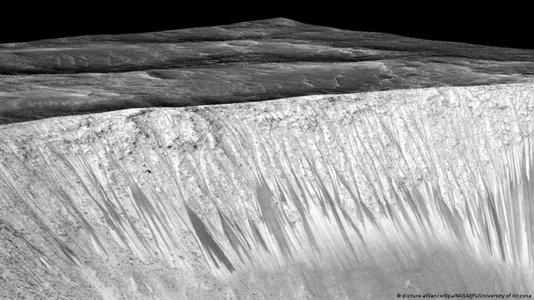
-
Published: 02 May 2023

Chinese Mars Exploration Rover Zurong has found evidence of liquid water in the planet's low latitudes, the warmest regions on Mars.
Edited by | Christian Megan
researches section
2 May 2023
According to a new study, there was no available evidence of liquid water at the planet's lower latitudes, where surface temperatures are highest. But the results from the Churong spacecraft fill in that gap.
"Churong" is part of China's Mars Exploration Mission "Tianwen-1". It landed on Utopia Planitia, a vast plain in the northern hemisphere of Mars, on May 15, 2021.
It covered a distance of about two kilometers and transmitted a huge amount of data to Earth before going into hibernation mode. Its landing site was in the low latitudes of Mars. Since then, a team of more than 20 researchers at the Chinese Academy of Sciences has used the data obtained by the rover's cameras and detectors to study the surface features and physical compositions of the sand dunes in the landing area.
They found some important morphological features on the dune surfaces, such as scales, cracks, grains, polygonal edges, and a ribbon-like effect.
The results of the data analysis showed that the surface layer of the sand dunes is rich in minerals, including hydrated sulfate, hydrated silica, and ferrihydrite.
Chen Xiaoguang, a principal investigator working at the Institute of Geology and Geophysics under the Chinese Academy of Sciences, said: "According to the meteorological data measured by 'Churong' and other Mars rovers, we concluded that the surface properties of the sand dunes are related to the liquid salt water generated by the subsequent melting of frost and snow falling on the surface. The surfaces of sand dunes contain salt when cooling occurs," according to Xinhua.
Chen explained that the salts in the sand dunes cause frost and snow to melt at low temperatures to form salty liquid water. When the brine dries, the precipitated hydrated minerals bind the sand particles to form pebbles and crusts. Then the scales crack further by shrinkage. Repeating the process at a later time resulted in polygonal ridges and a ribbon-like effect on the surface of the shell.
{source}<script async src="https://pagead2.googlesyndication.com/pagead/js/adsbygoogle.js?client=ca-pub-4474625449481215"
crossorigin="anonymous"></script>
<!-- moss test ad -->
<ins class="adsbygoogle"
style="display:block"
data-ad-client="ca-pub-4474625449481215"
data-ad-slot="6499882985"
data-ad-format="auto"
data-full-width-responsive="true"></ins>
<script>
(adsbygoogle = window.adsbygoogle || []).push({});
</script>{/source}
